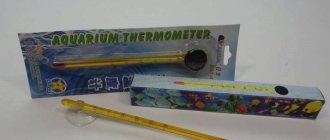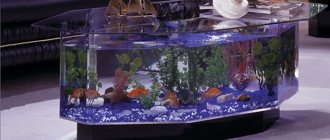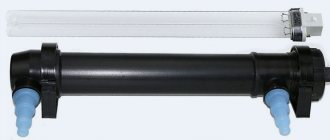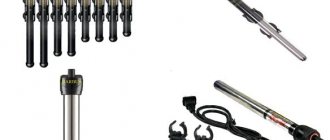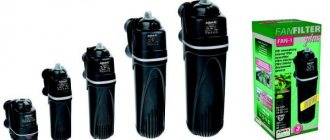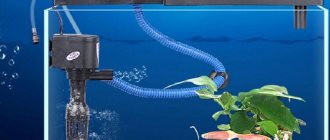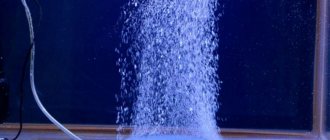Aquascape Promotion > Articles about aquascaping >
What is a drop checker and how does it work?
Firstly, why is it called drop checker? The name comes from the English version of Dropchecker, where check from English means check, and drop is translated as drop. Outwardly, a drop checker resembles a drop, although similar devices of a different shape have already appeared, but the name drop checker has become strongly entrenched among aquarists.
As you already understood from the first paragraph, a drop checker is a test. And it is used to determine the concentration of CO2 in the aquarium. Often a drop checker is also called a long test. Why? More on that later.
Why do you need a drop checker?
Knowing and monitoring CO2 levels is important in an aquarium with live plants, especially with an additional carbon dioxide supply system. Carbon dioxide is required by all living plants for the process of photosynthesis and proper growth. The plant uses light energy to separate carbon from carbon dioxide to produce carbohydrates. When carbohydrates are combined with phosphate, nutritious sugar is created, and it is already used by the plant for nutrition, growth and reproduction. Sugar is so important for the proper nutrition of plants that any lack of carbon is immediately felt by the plant, and the stronger the lighting, the more plants need CO2.
Many aquarium plants require strong lighting, and with strong lighting there is not enough CO2 naturally dissolved in the water. Bright light and the supply of CO2 are especially important for plants with leaves of red shades - the stronger the lighting, the better the nutrition, the brighter and more saturated the color of the leaves. In aquariums with strong lighting or with a large number of plants, it is recommended to additionally introduce carbon dioxide into the water. The methods can be different: using liquid infusions, special equipment or a homemade device, but the level of CO2 in the aquarium must be controlled.
For this task, a simple device is used - a drop checker. This device is filled with liquid with a CO2 indicator. You can determine the level of carbon dioxide by the color of the liquid.
- Blue color means there is not enough carbon dioxide.
- Yellow color - too much CO2.
- Green indicates that CO2 in the water is within normal limits.
In case of a change in CO2 level, the indicator liquid does not change color immediately, but within several hours, it is important to know about this.
To ensure proper operation of the device, the fluid is changed every 4-6 weeks. It is correct to change the liquid on time , before it begins to lose color and becomes transparent.
Purpose
The term, complicated for the Russian language, comes from the English drop (drop) and check (check). The first device invented looks like a drop. Until now, aquarists prefer to use this form, although others have been invented.
To live, plants need intense lighting and a sufficient amount of CO2 dissolved in the aquatic environment. Plants with red-brown foliage especially need this.
The volume of carbon dioxide in the aquarium is determined through long-term testing using a drop checker. Thanks to this device, you can objectively assess the situation. In accordance with the data obtained, the carbon dioxide concentration is gradually reduced or increased, regulating the intensity of the growing season of aquatic plants. At the same time, they monitor the illumination of the artificial reservoir.
On a note! When the carbon dioxide concentration is reduced from 30 mg/l to 15 mg/l, the illumination power is reduced to 0.5 watt/l. Without a drop checker you won’t be able to control it like that.
How to choose a drop checker
These devices come in different shapes, sizes, and materials. On sale you can find drop checkers made of plastic and blown glass. The more exotic the device, the more expensive it is. Glass looks more aesthetically pleasing and attractive in an aquarium, but the shape of the drop checker does not matter. In some cases, the shape or design of the device makes it difficult to determine the color.
Some drop checkers are sold complete with a reagent and water of the correct hardness; in others, the indicator and liquid are already mixed. It doesn’t matter which option you choose, both will work, although the ready-made mixture is more convenient.
Manufacturers
There are many companies involved in the production of drop checkers. The most popular among them:
- ISTA (Taiwan) . They produce devices of different designs. Some have the shape of a ball, while the length of the air layer is minimal. There are devices in the form of a cone or a rectangular parallelepiped.
- VIV (China) . Glass devices without suction cups. Hang on the edge of the tank. Looks like an elegant accessory to an artificial pond.
- Sera GmbH (Germany) . The devices consist of a transparent cone-shaped chamber for the indicator and a cylindrical capsule with a transition zone.
- Aquayer (Ukraine) . Drop checkers have a traditional shape. The CO2 content is determined half an hour after immersion in an aquatic environment. These are high-quality and inexpensive devices that completely solve the problem.
There is no need to overpay for expensive branded devices. There are no significant differences in the quality and speed of monitoring between expensive and budget devices. Almost the entire difference lies in the design and durability of the materials used. For some aquarists, devices with a simple scale that show deviations from the norm are convenient; for others, an accurate color scale with a decoding of CO2 concentration is important. Some devices are equipped with an additional scale that shows the degree of acidity.
On a note! The devices are equipped with ready-made or concentrated indicator solutions, which are diluted in distilled water. It is important to choose a high-quality indicator, otherwise you will not be able to get the correct result.
Preparation, installation, how to use
- Draw 1.5 ml of distilled water (or already mixed liquid) from the bottle into a syringe and release the liquid into a drop checker.
- If the reagent is separated from the water, it is then added to the water. The container must be gently shaken to mix the liquid. The solution will turn blue-green, indicating a pH of about 7.
- Now the device must be turned over very carefully so as not to spill any liquid.
- The drop checker, held level, is lowered into the water of the aquarium and, in the same position, installed on the glass of the tank anywhere so that you can freely observe the liquid. The vessel should be filled with air, not water.
- The color of the indicator liquid changes very slowly, it is important to remember this. After the start of CO2 supply, the gas concentration in the water can only be judged 2 hours after the start of the process, so patience is important here.
- The smaller the bubbles of the gas supplied to the water, the better it dissolves in water, the higher the concentration will be, so not only the speed of gas supply is important, but also its atomization.
- It is recommended to replace the indicator fluid in the device with each water change.
- It is not necessary to turn off the CO2 supply at night, but many people prefer to do so. At night, plants do not consume carbon dioxide, so the CO2 level can double overnight, while animals actively consume oxygen.
- In most cases, a 30 ppm CO2 supply is sufficient for live plants to achieve the nominal gas concentration level, for a heavily lit aquarium, or an aquarium with a large number of plants.
Budget CO2 cylinder system for an aquarium.
I recently had a post about a CO2 generator using soda. It was, let's say, a sample. It allows you to understand whether CO2 is needed in your aquarium or not. If you decide that you need it, then it’s time to think about how not to go broke on citric acid. Today I will tell you how to build a simple CO2 cylinder system. All components are available in any hardware store. We will calculate the approximate budget along the way. So, as a base, I use a carbon dioxide fire extinguisher. They vary from OU-1 to OU-5, OU-10 and even OU-55. The number on the marking tells us the volume of the fire extinguisher. I took OU-5. But this is out of greed. You can take a smaller one.
This is what he looks like. It will last me for a couple of years, even taking into account the fact that I have a large jar. You can take a smaller one. Price OU-5 Something about 1400 rubles.
The pressure in the fire extinguisher is about 55 atmospheres. A bit much. Need a gearbox. You can take an industrial one.
This is roughly what he looks like. The price is about 1000 rubles. For example, UR-6-6 costs 1150 rubles according to Google. You can use oxygen. You can BU. You never know what's lying around in the garage.
Now we need to pair the fire extinguisher with the gearbox. There are two options. Option number one. The most correct. We go to the turner and say that we need an adapter from M16X1.5 to 3/4 inch pipe thread. Both threads are external. The turner understood me. If you don’t want to say, take a picture and print it out.
It should look something like this:
The second option is less correct. I haven't tried it, but people write that it works. We buy a 3/4 by 3/8 barrel at a construction store. There is just the right thread on one side, and a suitable diameter of 17mm on the other. Only the carving is different. We buy an M16x1.5 die and re-cut the thread. I couldn't find the price for the barrel.
Carbon dioxide level in water
Maintaining the correct level of CO2 concentration in water is very difficult because carbon dioxide does not dissolve in water as easily as liquid. This process can be 10,000 times slower than the dissolution of gas in air. Even with a slight change in the rate of carbon dioxide supply and an increase in light intensity, this can have a negative effect on plants, their CO2 consumption drops and growth is reduced. And the higher the water temperature, the less carbon dioxide dissolves in it, and since most aquariums are tropical, it is even more difficult to saturate the water with a sufficient level of carbon dioxide.
- It is known that approximately 90% of the gas supplied to the aquarium is immediately released into the atmosphere, and only 10% goes to aquatic plants.
Dependence of CO2 and pH levels on carbonate hardness (kN) of water
When CO2 is dissolved in water, a small part of it, less than 0.2%, combines with water to form carbonic acid. The better carbon dioxide dissolves in water, the more the PH level decreases. An increase in pH level to 6-7 indicates a tenfold decrease in the concentration of carbonic acid, and a drop to 6-5, on the contrary, indicates a tenfold increase in concentration.
kH or carbonate hardness is a measure of the carbonate and bicarbonate content of water. These are the same products that are formed when carbon dioxide is dissolved in water. However, if these substances are already present in the water, neutralization of the acid occurs, meaning the carbonate and bicarbonate act as a buffer to maintain a higher pH level, even if large amounts of CO2 are introduced into the water. This is why kH is known as an indicator of the “alkalinity” of water (the higher the “alkalinity”, the higher the PH).
Therefore, it is important to know that if tap water has a pH of 7.2 and a kH of 10 (high levels of carbonate and bicarbonates), then 30 ppm of dissolved CO2 will only lower the pH to 7.0.
Dependence of CO2 and pH levels on carbonate hardness (kN) of water
Conversely, if the water is soft with kH 6 and pH 7.2, then more acid will form in the water, and 30 ppm of carbon dioxide will cause the pH to drop to 6.8.
This is important to know in order to understand why sometimes supplying the same amount of CO2 to an aquarium leads to different pH levels, and accordingly, the level of carbon dioxide in the water.
